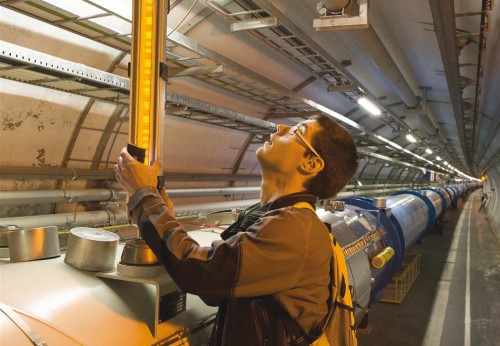
Hard at work at the LHC (Courtesy: CERN/Samuel Morier-Genoud)
By Hamish Johnston
Recently I had the pleasure of speaking to CERN’s Steve Myers who is supervising the herculean task of upgrading the superconducting magnets that guide protons around the Large Hadron Collider (LHC).
Over the next year or so there will be about 400 people deep below the flat countryside between Geneva and the Jura Mountains working on the LHC. The collider has been shut down since February and long-planned repairs and upgrades have already begun on parts of the 27 km beamline and the LHC’s four experiments.
About 250 of these workers are focusing on the 10,000 or so superconducting interconnects between the dipole magnets of the LHC. It was one of these interconnects that failed in 2008, leading to an explosion that shut down the collider for more than a year. The upgrade involves checking (and repairing if necessary) each interconnect – which is essentially a splice between two superconducting cables.
At the same time the “copper bus bars” surrounding the splices will be upgraded. These play a fail-safe role by providing a bypass for the huge current flowing through the magnets if and when the cables cease to be superconducting. In addition to this herculean task, four quadrupole and 15 dipole magnets will be replaced and checks will be made of the LHC’s electric, vacuum and cryogenics systems.
CERN has decided to initially run the LHC at 13 TeV – rather than its design energy of 14 TeV – when it fires up again in 2015. The problem is related to magnet training – which involves ramping up the current in a magnet until the huge magnetic forces cause a sudden movement within the superconducting coils. The resulting friction heats up the coil so it is no longer superconducting and the magnet “quenches”. This process is repeated several times until the magnet can run at its operating current without quenching. Reaching 13 TeV would involve a training programme of about 25 quenches per octant of the LHC whereas reaching 14 TeV would take as much as 200. As well as taking time, 200 quenches would inflict wear and tear on the magnets.
When I was at CERN a few weeks ago, all the physicists that I spoke to did not seem bothered by this lower collision energy. I’m not sure if they were all towing the party line, or hoping that the collider will eventually be run at 14 TeV.
“…towing the party line” in the penultimate line of the report is good. I wish I had said that. Alas, I lost my toes to a surgeon’s scalpel, and since then have had to satisfy myself with towing the line that any party throws to me.
As a complete lay person to the article regarding the LHC and the work involved by all at CERN’s
Generaly and your expierients keep it up we can’t stay on this earth forever but a guessed u know that that’s exactly why ya so busy brilliant stuff